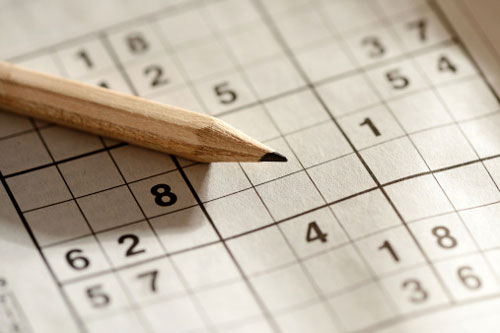 According to a case report recently published online in JAMA Neurology, researchers describe a rare incident where a man had developed seizures brought on by completing Sudoku puzzles.
According to a case report recently published online in JAMA Neurology, researchers describe a rare incident where a man had developed seizures brought on by completing Sudoku puzzles.
The patient was a 25-year-old right-handed physical education student who was recently involved in an avalanche accident.
The skier was buried under the snow and was hypoxic (oxygen deficient) for 15 minutes until he was rescued by a friend who performed cardiopulmonary resuscitation (CPR). He sustained a ruptured spleen and fractured ribs. He also developed involuntary myoclonic jerking of the legs and mouth. This made it hard for him to walk and talk.
Later on, as the man was working on Sudoku puzzles, he experienced clonic seizures of the left arm—this is a type of generalized seizure that affects the entire brain.
Sudoku puzzles require you to fill in a grid so that every row, column, and box (three squares by three within the grid) contains the numbers one through nine without repeating in any one row, column, or box.
In this case, the patient used “3D imagination” to solve the puzzle, according to Dr. Berend Feddersen from the Department of Palliative Medicine, Klinikum Innenstadt, at the University of Munich in Germany. In an interview with Medscape Medical News, Dr. Feddersen notes that, “He told me that he concentrated on one point or number and then arranged other numbers around it.”
A Functional MRI showed this mental imagination while completing the puzzle led to overactivation of the right central parietal cortex.
Imaging showed a loss of right centroparietal inhibitory neurons called U fibers. This injury resulted in three-fold increased evoked potentials at the right postcentral gyrus after somatosensory stimulation of the left median nerve. The deficiency in oxygen reaching the tissues may have caused some damage and a regional loss of right centroparietal U fibers, resulting in impaired inhibition. Study authors explained that functional activation of the hyperexcitable region caused focal epileptic seizures.
Dr. Feddersen notes that other visual tasks triggered the seizures: “For example, when we gave him the numbers 7, 2, 1, 8 and asked him to sort them numerically to 1, 2, 7, 8, the same thing happened.”
The case is rare, the only one worldwide, according to Dr. Feddersen.
“Normally, someone suffering hypoxia is more severely injured and then the brain is more damaged, so you can’t produce this kind of overactivation, or you aren’t damaged and you’re in a healthy condition, without any injury,” he explained. “It’s very seldom that you get a case with damage only to this part of the brain and only to the U fibers that lead to impaired inhibition.”
To date, the patient no longer does Sudoku puzzles and has been seizure-free for over five years. Physiotherapy has been a huge help, although he still has difficulty talking and walking.
Source for Today’s Article:
Anderson, P., “Sudoku and Seizures?” Medscape web site, October 22, 2015; http://www.medscape.com/viewarticle/853085?nlid=89449_3681&src=wnl_edit_dail&uac=247315HK&impID=865708&faf=1.
